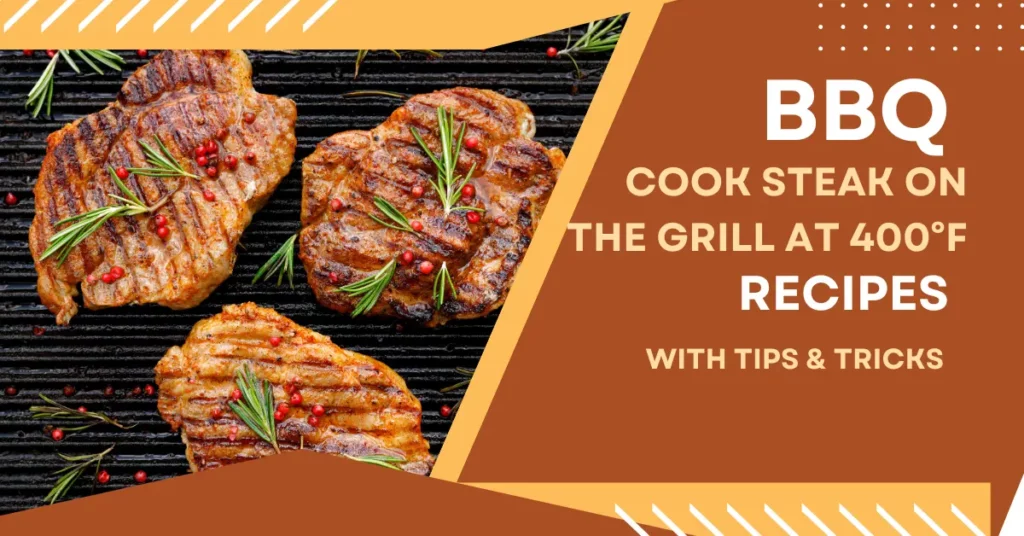This post may contain affiliate links. If you use these links to buy something we may earn a small commission. Thanks.
Grilling steak is an art, and temperature control is one of the most critical elements of achieving that juicy, flavorful, restaurant-quality bite. If you’ve been wondering how long to cook steak on the grill at 400°F, you’re in the right place. This guide breaks down everything you need to know from timing by doneness and steak cuts to grilling techniques and expert tips.
Whether you’re a weekend BBQ warrior or just starting your grilling journey, mastering steak at 400°F can elevate your entire cookout game.
Why 400°F is a Sweet Spot for Grilling Steak
Grilling at 400°F provides a balance between getting a flavorful sear and keeping the inside tender and juicy. It’s hot enough to caramelize the surface and develop those iconic grill marks, yet not so hot that the steak becomes overcooked before the inside reaches your desired level of doneness.
Cooking steak at this temperature offers speed, flavor, and a better chance of hitting that perfect medium-rare or medium finish that most steak lovers crave.

What Influences Steak Cooking Time on a 400°F Grill?
Not all steaks cook the same way, even at the same temperature. Here are the key factors that determine how long your steak needs to stay on the grill:
1. Steak Thickness
- A thin ½-inch steak may cook in just 2 minutes per side.
- A 1½–2 inch thick steak could take double or triple the time.
2. Steak Cut
- Different cuts like Ribeye, Filet Mignon, or Sirloin have varying fat content, textures, and densities, all of which influence cook time.
3. Desired Doneness
- Rare steaks require less time; well-done steaks need more.
- Internal temperature is more accurate than timing alone.
4. Bone-in vs Boneless
- Bone-in steaks often take longer to cook through, as the bone acts as an insulator.
5. Type of Grill
- Gas grills heat more consistently, while charcoal can fluctuate.
- Grate material also impacts sear quality and heat retention.
6. Starting Temperature of Steak
- A cold steak from the fridge will take longer than one brought to room temperature before grilling.
General Grilling Times at 400°F (Based on Doneness)
| Doneness Level | Internal Temp | Time per Side (Approx.) |
|---|---|---|
| Rare | 120–125°F | 2–3 minutes |
| Medium-Rare | 130–135°F | 3–4 minutes |
| Medium | 140–145°F | 4–5 minutes |
| Medium-Well | 150–155°F | 5–6 minutes |
| Well-Done | 160°F+ | 6–7 minutes |
Keep in mind: Always use a meat thermometer to confirm doneness instead of relying solely on time.
Estimated Cook Times by Popular Steak Cuts at 400°F
Ribeye Steak
Rich marbling makes ribeye a grilling favorite. At 400°F:
- 1-inch thick: 4 min per side (medium-rare)
- 1.5-inch thick: 5–6 min per side
New York Strip
Bold flavor and a firmer bite. At 400°F:
- 1-inch thick: 4–5 min per side (medium)
- 1.5-inch thick: 6–7 min per side (medium-well)
Filet Mignon
Tender and lean, filet cooks quickly but must be watched carefully.
- 1.5–2 inches thick: 5–6 min per side (medium-rare)
- Optional: Finish in indirect heat or oven if needed
Sirloin Steak
Lean and budget-friendly.
- 1-inch thick: 3–4 min per side (medium-rare)
- Thicker cuts: Add an extra minute per side
T-Bone/Porterhouse
A dual-cut steak with filet and strip in one.
- 1.25-inch thick: 5–6 min per side (medium)
- Bone-in adds time—check internal temp carefully
Step-by-Step Guide: How to Grill the Perfect Steak at 400°F
1. Preheat the Grill
- Get your grill to a steady 400°F.
- Clean and oil grates to prevent sticking.
2. Bring Steak to Room Temperature
- Take steak out of the fridge 30–60 minutes before cooking.
- This ensures even cooking and better texture.
3. Season Generously
- Keep it simple: salt, black pepper, olive oil.
- Or use dry rubs and marinades depending on flavor preference.
4. Oil the Grates
- Brush oil on grates or directly on steak.
- This prevents sticking and enhances sear marks.
5. Place Steak on the Grill
- Position over direct heat.
- Close lid to maintain consistent internal grill temperature.
6. Flip Once
- Flip steak only once for best grill marks and texture.
- Avoid frequent turning—it disrupts caramelization.
7. Monitor Internal Temperature
- Insert a meat thermometer into the thickest part.
- Don’t rely solely on color or timing accuracy is key.
8. Rest the Steak
- Remove steak 5°F below target temp.
- Let it rest for 5–10 minutes before slicing.
- Resting redistributes juices and enhances flavor.
Expert Grilling Tips to Level Up Your Steak Game
- Use Tongs, Not Forks: Piercing steak lets juices escape.
- Butter Basting: Add butter, garlic, and herbs during the last minute for added richness.
- Two-Zone Grilling: Sear over direct heat, finish over indirect heat for thicker cuts.
- Close the Lid: Retains heat and shortens cook time.
- Experiment with Wood Chips: Add smoky flavors with mesquite, hickory, or cherry wood.
Why a Meat Thermometer Is Non-Negotiable
Even seasoned grillers rely on thermometers for consistency. An instant-read thermometer helps you:
- Avoid undercooking or overcooking.
- Get precise doneness every time.
- Safely serve steak without guesswork.
Tip: Insert into the thickest part of the steak, avoiding bone or fat pockets.
Common Mistakes to Avoid When Grilling Steak at 400°F
- Grilling Cold Steak: Leads to uneven cooking.
- Skipping Preheat: Lowers sear quality.
- Overcooking: Easy to do without a thermometer.
- Not Letting Steak Rest: Juices will spill out when sliced too soon.
- Cooking on Dirty Grates: Causes sticking and off-flavors.
Quick Reference: Internal Temp & Texture Guide
| Doneness | Internal Temp | Look & Feel |
|---|---|---|
| Rare | 120–125°F | Cool red center, very soft |
| Medium-Rare | 130–135°F | Warm red center, tender |
| Medium | 140–145°F | Pink center, slightly firm |
| Medium-Well | 150–155°F | Slightly pink, firmer |
| Well-Done | 160°F+ | Brown throughout, firm |
Final Thoughts
Cooking steak on a grill at 400°F is a fantastic method to lock in flavor while achieving your preferred doneness quickly and consistently. Timing is essential but it’s the combination of steak cut, thickness, and internal temperature monitoring that leads to mouthwatering success.
So next time you fire up the grill, remember: don’t just wing it follow this guide, trust your thermometer, and you’ll be slicing into steakhouse-level results right in your backyard.
